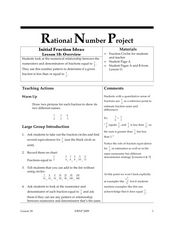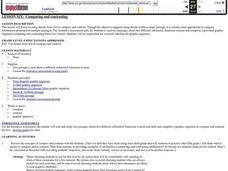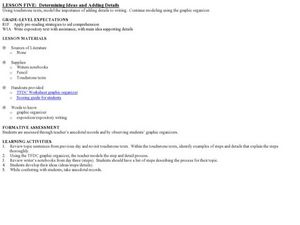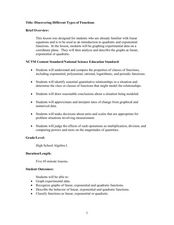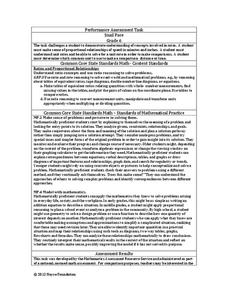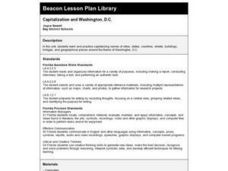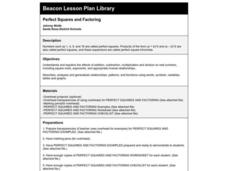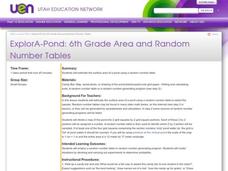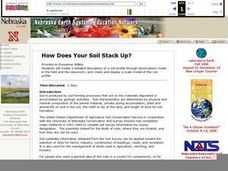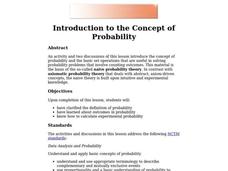Curated OER
Initial Fraction Ideas Lesson 15: Overview
Observe fraction numerators and denominators to determine if they are less than or equal to 1/2. In this fractions lesson plan, students simplify fractions and determine their relationship to 1/2.
Curated OER
Literary Response and Analysis
Students analyze the archetype of 'the fall' in Shakespeare's Macbeth. In this literary analysis lesson, students work in tiered learning groups to analyze the characters of Macbeth and Lady Macbeth. Students use the book of Genesis as...
Curated OER
Comparing and Contrasting
Analyze historical biographies. Young scholars compare and contrast the biographies of Susan B. Anthony and Pat Nixon. They construct graphic organizers, answer critical thinking questions, complete a formative assessment.
Curated OER
Determining Ideas and Adding Details
A handy TFDC (topic/fact/detail/conclusion) graphic organizer (included) allows young writers to outline and record their main ideas and supporting details in the prewriting phase. They then continue to add details to the topic sentences...
Curated OER
More Details and Transitions
Use details and transition words to enhance writing. Sixth graders examine their own writing and insert more details and transition words provided by their teacher. There is a list of 11 "Terrific Transitions," but brainstorm several...
Curated OER
Discovering Different Types of Functions
Graph polynomials and identify the end behavior of each polynomial function. The class differentiates between linear, quadratic, and other polynomial equations.
Curated OER
The Catcher in the Rye: Vocabulary Self-Collection Strategy
Group members select a word from The Catcher in the Rye they would like the class to know more about. After identifying the context and determining the meaning of the word from the context, they present the word to the entire class,...
Noyce Foundation
Snail Pace
Slow and steady wins the race? In the assessment task, scholars calculate the rates at which different snails travel in order to find the fastest snail. Hopefully, your class will move much more quickly in finishing the task!
Curated OER
Ordering Integers
Sixth and seventh graders compare and order integers. After locating integers in a newspaper, they describe examples of negative and positive integers. They draw a thermometer and locate positive and negative integers on the scale. In...
Curated OER
Multiplying with Egg O
Third graders multiply whole numbers by one and two digit numbers using base ten blocks and Egg O multiplication game. students pass out egg cartons, counters, and a record sheet to each group.
Curated OER
Capitalization and Washington, D.C.
Second graders learn and practice capitalizing names of cities, states, countries, streets, buildings, bridges, and geographical places around the theme of Washington, D.C. through activities at learning centers in the classroom.
Curated OER
What Color is It?
Students indentify whether an objects reflects or absorbs red, green, and/or blue light. They create a simple spectral signature.
Curated OER
Finding Polygons in Cubist Art
Fourth graders explore geometric properties and relationships in a two-dimensional work of art. They first search for and identify polygons in a Cubist painting and then use polygons to create their own Cubist portrait of a classmate.
Curated OER
Perfect Squares and Factoring
A teacher guided lesson on perfect squares and factoring. They discuss perfect squares, observe the expansion steps for finding the product, and practice solving problems. They complete a worksheet on perfect squares and factoring.
Curated OER
"Archeology Dig"
Students simulate archaeologists as they dig through a bag with found items in order to arrive at conclusions about the people they are studying.
Curated OER
Enjoying the Adventure
Students watch the video of "The Prince and the Pauper" and analyze, compare and contrast the characters. They write letters to a character from the point of view of another character and create a new ending to the play.
Curated OER
ExplorA-Pond: 6th Grade Area and Random Number Tables
Sixth graders estimate surface area of a pond using a random number table.
Curated OER
How Does Your Soil Stack Up?
Students examine the soil in their local area and create a soil profile. They record observations in the field and the classroom. They create their own display of the soil profile as well.
Curated OER
Identifying Opportunity Cost
High schoolers work together to examine the concept of opportunity costs. They complete a practice problem and solve other problems during the class period. They share their solutions with the class.
Curated OER
Introduction to the Concept of Probability
Middle and high schoolers have a clarified definition of probability, they explore about outcomes in probability and how to calculate experimental probability. They use computers to learn about probability.
Curated OER
"Continents"
Students review game directions along with the continents. They sing a song together and respond with a movement depending on the continent which is called out by the teacher.
Curated OER
Teaching Summarization
Examine the process of summarizing a piece of text using the book So You Want to Be a President? Kids review the definitions for main idea, topic sentences, superordinate terms, and supporting details. Next, they work in small...
Curated OER
Ant Writing
Students become effective writers. They need to practice strategies for working through the writing process. By presenting the students with a creative problem, they must choose a position and support it accordingly.
Curated OER
Imperialism in China
If you are completing a unit on the European impact on China, this short lesson may be useful. It requires an excerpt from Chinese Civilization: A sourcebook, by Ebrey, that gives Liang Qichaos's account of his visit to America....
